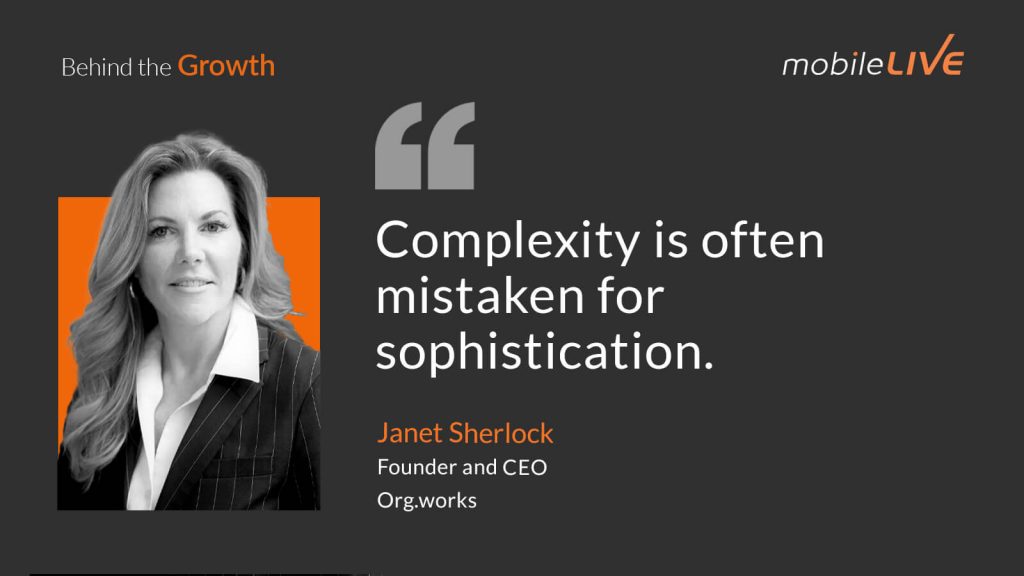Key Insights
Structural misalignment quietly undermines execution at every level
Enterprises often focus on top-line strategy but overlook how deeply structure determines success. When a company organizes around the wrong axis, say, by geography instead of product, it can disrupt everything from go-to-market operations to performance metrics. This mismatch creates a slow erosion of execution that may go unnoticed until performance slips. Janet outlines that structure isn’t just an HR design choice; it’s foundational to how work gets done.
Org complexity doesn’t signal sophistication—it signals friction
In large enterprises, complexity often creeps in under the guise of progress. New executive roles, overlapping functions, and transformation offices may look strategic on paper, but typically signal unresolved problems. Janet shares that many organizations now carry unnecessary departments designed solely to bridge internal gaps; teams that exist because core structures aren’t working. For example, if marketing and sales need a dedicated team just to collaborate, that’s not innovation—it’s a failure of structural clarity.
AI success depends more on structure than on tools
Most enterprises treat AI as a technology investment, but it’s far more dependent on how the organization is structured. Janet introduces a model with three tiers: a Center of Enablement (typically within IT), Federated Model Ownership (embedded in functions like marketing or supply chain), and Democratized Data and Insights (accessible across the org). This model ensures clarity in who owns what and enables AI to scale without becoming a bottleneck. Without this kind of structure, companies end up with fragmented ownership, duplicated efforts, and governance breakdowns.

Episode Highlights
Less But Better Isn’t a Buzzword
Janet breaks down the real meaning behind her organizational philosophy: “less but better.” Instead of bloated transformation offices or redundant roles, she pushes for fewer layers, fewer handoffs, and cleaner accountability. It’s a deliberate rejection of complexity disguised as progress—a reminder that efficiency starts with clarity.
“Complexity is often mistaken for sophistication.”
Structure Shouldn’t Need an Interpreter
Janet delivers a sharp rebuke to over-engineered org charts. She explains that when structure is clear, organizations move faster and perform better—without relying on consultants to decode the hierarchy. Simplicity isn’t just an aesthetic; it’s operational advantage.
“If you can get the structure right, you don’t need another team or consultant to interpret the structure for you.”
When Pre-Meetings Signal a Problem
Janet outlines the subtle but revealing signs that a structure is failing—like the number of pre-meetings before a meeting. These friction points aren’t always visible on an org chart, but they cost time, energy, and clarity. For executives, they’re red flags of hidden inefficiencies.
“If you end up having to align different departments so that you can come across as aligned in an executive meeting or a board meeting, that’s a sign.”
Boards Are Asking Smarter AI Questions
Janet observes that boards have evolved from asking what AI is to asking how it’s being governed. They’re looking beyond innovation to risk, structure, and accountability—pressing questions that can’t be answered with tech stacks alone.
“Boards are starting to ask much better questions. What is the AI strategy? Where is AI being used? Who’s accountable for outcomes?”
Don’t Put AI Agents in the Org Chart
In a fast-emerging debate, Janet offers a strong take: AI agents don’t belong in org charts. Instead, orgs should create flexible structures that support evolution—while still giving people the stability they need to operate effectively.
“Build it so there’s enough flexibility that people and processes and agents have space to change and move and migrate, but keep some stability within the organization.”







